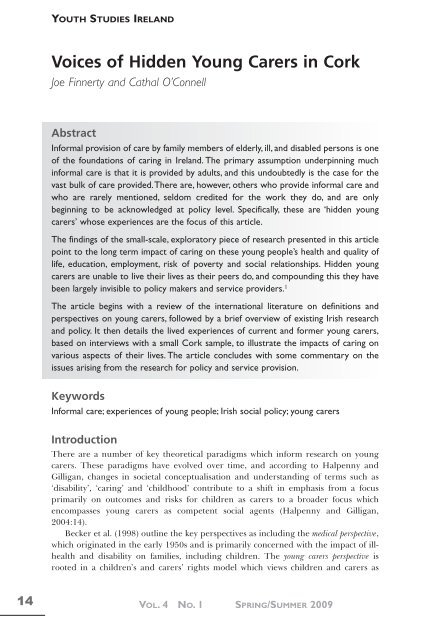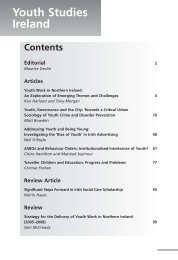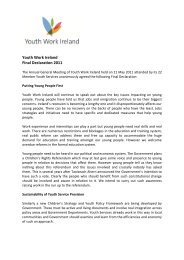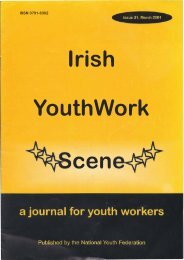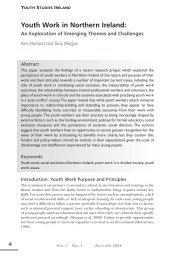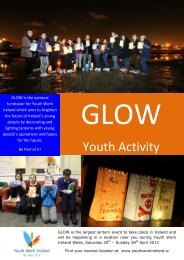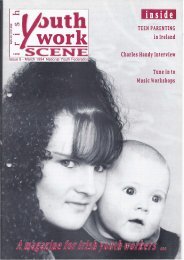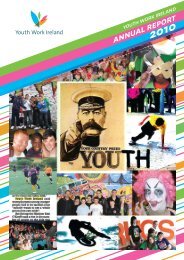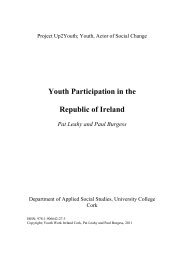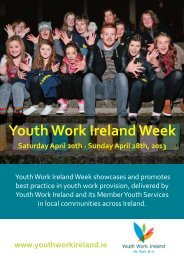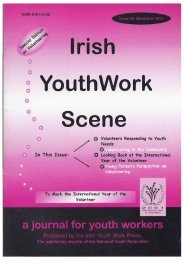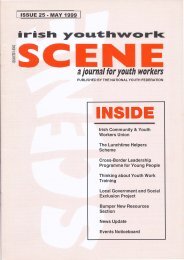Voices of Hidden Young Carers in Cork, Joe Finnerty and Cathal O ...
Voices of Hidden Young Carers in Cork, Joe Finnerty and Cathal O ...
Voices of Hidden Young Carers in Cork, Joe Finnerty and Cathal O ...
Create successful ePaper yourself
Turn your PDF publications into a flip-book with our unique Google optimized e-Paper software.
YOUTH STUDIES IRELAND<strong>Voices</strong> <strong>of</strong> <strong>Hidden</strong> <strong>Young</strong> <strong>Carers</strong> <strong>in</strong> <strong>Cork</strong><strong>Joe</strong> F<strong>in</strong>nerty <strong>and</strong> <strong>Cathal</strong> O’ConnellAbstractInformal provision <strong>of</strong> care by family members <strong>of</strong> elderly, ill, <strong>and</strong> disabled persons is one<strong>of</strong> the foundations <strong>of</strong> car<strong>in</strong>g <strong>in</strong> Irel<strong>and</strong>. The primary assumption underp<strong>in</strong>n<strong>in</strong>g much<strong>in</strong>formal care is that it is provided by adults, <strong>and</strong> this undoubtedly is the case for thevast bulk <strong>of</strong> care provided.There are, however, others who provide <strong>in</strong>formal care <strong>and</strong>who are rarely mentioned, seldom credited for the work they do, <strong>and</strong> are onlybeg<strong>in</strong>n<strong>in</strong>g to be acknowledged at policy level. Specifically, these are ‘hidden youngcarers’ whose experiences are the focus <strong>of</strong> this article.The f<strong>in</strong>d<strong>in</strong>gs <strong>of</strong> the small-scale, exploratory piece <strong>of</strong> research presented <strong>in</strong> this articlepo<strong>in</strong>t to the long term impact <strong>of</strong> car<strong>in</strong>g on these young people’s health <strong>and</strong> quality <strong>of</strong>life, education, employment, risk <strong>of</strong> poverty <strong>and</strong> social relationships. <strong>Hidden</strong> youngcarers are unable to live their lives as their peers do, <strong>and</strong> compound<strong>in</strong>g this they havebeen largely <strong>in</strong>visible to policy makers <strong>and</strong> service providers. 1The article beg<strong>in</strong>s with a review <strong>of</strong> the <strong>in</strong>ternational literature on def<strong>in</strong>itions <strong>and</strong>perspectives on young carers, followed by a brief overview <strong>of</strong> exist<strong>in</strong>g Irish research<strong>and</strong> policy. It then details the lived experiences <strong>of</strong> current <strong>and</strong> former young carers,based on <strong>in</strong>terviews with a small <strong>Cork</strong> sample, to illustrate the impacts <strong>of</strong> car<strong>in</strong>g onvarious aspects <strong>of</strong> their lives. The article concludes with some commentary on theissues aris<strong>in</strong>g from the research for policy <strong>and</strong> service provision.KeywordsInformal care; experiences <strong>of</strong> young people; Irish social policy; young carersIntroductionThere are a number <strong>of</strong> key theoretical paradigms which <strong>in</strong>form research on youngcarers. These paradigms have evolved over time, <strong>and</strong> accord<strong>in</strong>g to Halpenny <strong>and</strong>Gilligan, changes <strong>in</strong> societal conceptualisation <strong>and</strong> underst<strong>and</strong><strong>in</strong>g <strong>of</strong> terms such as‘disability’, ‘car<strong>in</strong>g’ <strong>and</strong> ‘childhood’ contribute to a shift <strong>in</strong> emphasis from a focusprimarily on outcomes <strong>and</strong> risks for children as carers to a broader focus whichencompasses young carers as competent social agents (Halpenny <strong>and</strong> Gilligan,2004:14).Becker et al. (1998) outl<strong>in</strong>e the key perspectives as <strong>in</strong>clud<strong>in</strong>g the medical perspective,which orig<strong>in</strong>ated <strong>in</strong> the early 1950s <strong>and</strong> is primarily concerned with the impact <strong>of</strong> illhealth<strong>and</strong> disability on families, <strong>in</strong>clud<strong>in</strong>g children. The young carers perspective isrooted <strong>in</strong> a children’s <strong>and</strong> carers’ rights model which views children <strong>and</strong> carers as14 VOL. 4 NO. 1 SPRING/SUMMER 2009
<strong>Voices</strong> <strong>of</strong> <strong>Hidden</strong> <strong>Young</strong> <strong>Carers</strong> <strong>in</strong> <strong>Cork</strong>fulfill<strong>in</strong>g dist<strong>in</strong>ct family <strong>and</strong> social roles, <strong>in</strong>clud<strong>in</strong>g be<strong>in</strong>g the ma<strong>in</strong> providers <strong>of</strong> care <strong>in</strong>the community. The social perspective on disability is primarily concerned with the rights<strong>and</strong> needs <strong>of</strong> disabled people <strong>and</strong> their experiences <strong>of</strong> ‘disabl<strong>in</strong>g barriers’ <strong>in</strong>clud<strong>in</strong>gdiscrim<strong>in</strong>ation <strong>and</strong> exclusion. Becker et al. (1998) identify what they term a ‘subliterature’<strong>of</strong> the social perspective on disability, which has challenged the ma<strong>in</strong>streamwork on young carers <strong>and</strong> has focused <strong>in</strong>stead on the rights <strong>and</strong> needs <strong>of</strong> those whohave physical or mental impairments (Keith <strong>and</strong> Morris, 1995; Parker <strong>and</strong> Olsen,1995; Newman, 2002). F<strong>in</strong>ally the family perspective has grown out <strong>of</strong> the debatebetween the rights <strong>of</strong> disabled people <strong>and</strong> the rights <strong>of</strong> children who care, emphasis<strong>in</strong>gprevention <strong>in</strong> a ‘whole family’ context as opposed to protection (Becker et al., 1998).Due to the complexity <strong>and</strong> diversity surround<strong>in</strong>g the role <strong>of</strong> young carers, asatisfactory def<strong>in</strong>ition has proved difficult to arrive at. Several def<strong>in</strong>itions <strong>of</strong> youngcarers can be identified with<strong>in</strong> the literature on social work <strong>and</strong> from car<strong>in</strong>gorganisations. A range <strong>of</strong> factors can be cited which set young carers apart from bothadult carers <strong>and</strong> other young children with<strong>in</strong> families <strong>and</strong> households who do not takeon a car<strong>in</strong>g role. Aldridge <strong>and</strong> Becker (1997) suggest the follow<strong>in</strong>g def<strong>in</strong>ition:A child or young person (under 18) who is carry<strong>in</strong>g out significant car<strong>in</strong>gtasks <strong>and</strong> assum<strong>in</strong>g a level <strong>of</strong> responsibility for another which would usuallybe undertaken by an adult.Research on <strong>Young</strong> <strong>Carers</strong> <strong>in</strong> Irel<strong>and</strong>There is little by way <strong>of</strong> a young carer research literature <strong>in</strong> Irel<strong>and</strong>, with exist<strong>in</strong>gresearch overwhelm<strong>in</strong>gly focus<strong>in</strong>g on adult caregivers (see for example O’Donovan etal., 1997; Garavan et al., 2001). While Halpenny <strong>and</strong> Gilligan (2004) have undertakena wide-rang<strong>in</strong>g literature review on young carers which surveyed the <strong>in</strong>ternationalliterature <strong>and</strong> policy context, they did not undertake any primary research withhidden young carers.Two short studies which made references to young carers were carried out <strong>in</strong> themid-1990s. The first was by Multiple Sclerosis Irel<strong>and</strong> (1996) on MS sufferers <strong>and</strong> thesecond was a pilot study by <strong>Carers</strong> Association (Irel<strong>and</strong>) (1997) which aimed to obta<strong>in</strong>an overall picture <strong>of</strong> the contexts with<strong>in</strong> which young people were provid<strong>in</strong>g care. TheMS Irel<strong>and</strong> study was focused on care needs <strong>of</strong> sufferers <strong>of</strong> that condition <strong>and</strong> thesource <strong>of</strong> the care they received while the <strong>Carers</strong> Association research focused on thenature <strong>of</strong> the tasks <strong>and</strong> extent <strong>of</strong> car<strong>in</strong>g undertaken by young people rather thanexplor<strong>in</strong>g the impacts on young carers <strong>and</strong> their attitudes <strong>and</strong> feel<strong>in</strong>gs <strong>in</strong> relation totheir car<strong>in</strong>g responsibilities.Policy <strong>and</strong> Provision <strong>in</strong> Irel<strong>and</strong>In the Irish context, recognition <strong>and</strong> responses to the existence <strong>and</strong> needs <strong>of</strong> youngcarers could be best described as uneven. No national policy strategy exists with anexplicit focus on young carers, <strong>and</strong> no reference to young carers is made <strong>in</strong> either theNational Children’s Strategy 2000–2010 or the Office for Social Inclusion (2007)publication A Social Portrait <strong>of</strong> Children <strong>in</strong> Irel<strong>and</strong>. Additionally, there is a noteworthyabsence <strong>of</strong> mention <strong>of</strong> the ‘young carer’ issue <strong>in</strong> the Comhairle document Support<strong>in</strong>g<strong>Carers</strong> (2002), or <strong>in</strong> the Jo<strong>in</strong>t Oireachtas Report on the Position <strong>of</strong> Full-Time <strong>Carers</strong> (2003).15
YOUTH STUDIES IRELANDThe same is true <strong>of</strong> other recent literature on car<strong>in</strong>g <strong>in</strong> Irel<strong>and</strong> (Cullen et al.,2004;NESC, 2005; Browne, 2005).However, evidence is now emerg<strong>in</strong>g <strong>of</strong> a belated awareness <strong>of</strong> the roles played byyoung carers <strong>and</strong> the subsequent needs <strong>of</strong> these young people. Some recognition <strong>of</strong>young carers is evident <strong>in</strong> a report entitled Implement<strong>in</strong>g Equality for <strong>Carers</strong> by theEquality Authority (2005), which asserts that ‘the state has a clear responsibility toprovide a full range <strong>of</strong> services for young carers’, beg<strong>in</strong>n<strong>in</strong>g by identify<strong>in</strong>g the youngcarers, followed by the provision <strong>of</strong> practical supports such as counsell<strong>in</strong>g, respite,access to education, social <strong>in</strong>clusion <strong>and</strong> meet<strong>in</strong>g personal development needs.Most recently, policy documents aris<strong>in</strong>g from the social partnership process overtlyacknowledge the existence <strong>of</strong> young carers as a specific cohort with<strong>in</strong> the car<strong>in</strong>gpopulation overall, especially where they may be undertak<strong>in</strong>g ‘<strong>in</strong>appropriate careroles’. Aris<strong>in</strong>g from the participation <strong>of</strong> the <strong>Carers</strong> Association <strong>in</strong> the negotiation <strong>of</strong> thecurrent national partnership agreement, Towards 2016, there is a commitment toundertake research on ‘the extent, degree <strong>and</strong> impact’ <strong>of</strong> car<strong>in</strong>g on the lives <strong>of</strong> thechildren concerned. It goes on to commit to the development <strong>of</strong> supports to ‘alleviatespecific problem areas identified for children’, based on the f<strong>in</strong>d<strong>in</strong>gs <strong>of</strong> the research(Government <strong>of</strong> Irel<strong>and</strong>, 2006: 46; see also <strong>Carers</strong> Association <strong>of</strong> Irel<strong>and</strong>, CarerAlliance Irel<strong>and</strong> <strong>and</strong> Car<strong>in</strong>g for <strong>Carers</strong> Irel<strong>and</strong>, 2008). The sporadic nature <strong>of</strong> policyrecognition <strong>in</strong> Irel<strong>and</strong> <strong>of</strong> young carers contrasts with that <strong>of</strong> other countries such as theUK <strong>and</strong> Australia, where significant progress has been made <strong>in</strong> identify<strong>in</strong>g <strong>and</strong>respond<strong>in</strong>g to their situation. 2The Prevalence <strong>of</strong> <strong>Young</strong> <strong>Carers</strong> <strong>in</strong> Irel<strong>and</strong>It is difficult to assess the true extent <strong>of</strong> car<strong>in</strong>g undertaken by young people <strong>in</strong> Irel<strong>and</strong>,though rough estimates can be made to gauge the extent <strong>of</strong> car<strong>in</strong>g by young peoplefrom census sources. The Census <strong>of</strong> Irel<strong>and</strong> 2002 <strong>and</strong> 2006 (Volume 10 <strong>Carers</strong> <strong>and</strong>Disability) provides data on self-reported car<strong>in</strong>g activities with<strong>in</strong> the population as awhole. With respect to persons <strong>in</strong> younger age groups who provide care, however,Census 2002 data are only available for persons from the age <strong>of</strong> 15 years upwards. Atotal <strong>of</strong> 2,996 persons aged between 15 <strong>and</strong> 17 years were recorded as provid<strong>in</strong>gunpaid personal care. Of these 819 were aged 15 years, 1037 were aged 16 <strong>and</strong> 1,140were aged 17, which <strong>in</strong> total accounted for 2 per cent <strong>of</strong> the total car<strong>in</strong>g population(Halpenny <strong>and</strong> Gilligan, 2004). It is not possible to make comparisons between 2002<strong>and</strong> 2006, as the latter census did not publish figures for persons <strong>in</strong> younger agegroups who provide care.Research Design <strong>and</strong> MethodologyThe rema<strong>in</strong>der <strong>of</strong> this article presents some <strong>of</strong> the f<strong>in</strong>d<strong>in</strong>gs <strong>of</strong> an exploratory CombatPoverty Agency funded study <strong>in</strong>to young carers’ experiences <strong>in</strong> the <strong>Cork</strong> region <strong>in</strong> thesouth <strong>of</strong> Irel<strong>and</strong>. Given the hidden nature <strong>of</strong> the role they fulfil, a major challengefac<strong>in</strong>g the research was the identification <strong>of</strong> a sample <strong>of</strong> young carers <strong>and</strong> ga<strong>in</strong><strong>in</strong>g theirconsent to participate <strong>in</strong> the study. 3 In attempt<strong>in</strong>g to identify potential participants,contact was made with a wide range <strong>of</strong> organisations <strong>and</strong> <strong>in</strong>dividuals who work withfamilies <strong>and</strong> young people <strong>in</strong> the wider <strong>Cork</strong> area <strong>and</strong> who could be <strong>in</strong> a position toidentify <strong>and</strong> <strong>in</strong>troduce young carers to the researchers. 4 Data was gathered via16 VOL. 4 NO. 1 SPRING/SUMMER 2009
<strong>Voices</strong> <strong>of</strong> <strong>Hidden</strong> <strong>Young</strong> <strong>Carers</strong> <strong>in</strong> <strong>Cork</strong>qualitative <strong>and</strong> semi-structured <strong>in</strong>terviews, which were conducted <strong>in</strong> awareness <strong>of</strong> thesensitive nature <strong>of</strong> the material <strong>in</strong>volved <strong>and</strong> the youth <strong>of</strong> some <strong>of</strong> the respondents. 5In total n<strong>in</strong>e <strong>in</strong>terviews with young carers – compris<strong>in</strong>g five young carers <strong>and</strong> fourformer young carers – were conducted from 2004 onwards <strong>in</strong> <strong>Cork</strong> city <strong>and</strong> county.Two <strong>of</strong> the young carers are sibl<strong>in</strong>gs. The <strong>in</strong>terview sample reflects a range <strong>of</strong> agegroups, with a roughly even balance <strong>of</strong> male <strong>and</strong> female participants (Table 1). Whileno young carers under twelve years <strong>of</strong> age were <strong>in</strong>terviewed, a number <strong>of</strong> theparticipants had been car<strong>in</strong>g from as young as four or five years <strong>of</strong> age.Age Female Male Total12–13 1 1 214–15 0 2 216–17 0 0 018–19 1 0 120s 0 1 130s 1 0 140s 1 0 150s 1 0 1Total 5 4 9Table 1: Interview participants by age <strong>and</strong> genderIn the follow<strong>in</strong>g section the young carers are pr<strong>of</strong>iled <strong>in</strong> terms <strong>of</strong> who they cared for,the duration <strong>of</strong> the care, <strong>and</strong> the nature <strong>of</strong> the care provided. This is followed by anaccount <strong>of</strong> their views on their car<strong>in</strong>g role, <strong>and</strong> the effects it has had on various aspects<strong>of</strong> their lives.Person Cared for <strong>and</strong> Reason for Car<strong>in</strong>gEight <strong>of</strong> the n<strong>in</strong>e young carers <strong>and</strong> former young carers <strong>in</strong>terviewed were car<strong>in</strong>g fortheir mother. The n<strong>in</strong>th <strong>in</strong>terviewee took over car<strong>in</strong>g for a younger sister when hermother suffered a nervous breakdown. Four <strong>of</strong> the young carers <strong>and</strong> former youngcarers were car<strong>in</strong>g for more than one person. In three <strong>of</strong> these cases, the carer alsotook responsibility for the care <strong>of</strong> a younger sibl<strong>in</strong>g, as their mother was unable to doso. The fourth carer was responsible for car<strong>in</strong>g for three people: her mother, aunt <strong>and</strong>gr<strong>and</strong>father.Length <strong>of</strong> Time Car<strong>in</strong>gA total <strong>of</strong> five young carers began car<strong>in</strong>g under the age <strong>of</strong> ten, four <strong>of</strong> whom begancar<strong>in</strong>g when they were less than six years <strong>of</strong> age. Four young carers <strong>and</strong> former youngcarers began car<strong>in</strong>g <strong>in</strong> their teenage years. All those <strong>in</strong>terviewed had been car<strong>in</strong>g for along period <strong>of</strong> time, from a m<strong>in</strong>imum <strong>of</strong> around four years up to over forty years <strong>of</strong>car<strong>in</strong>g. All <strong>in</strong>terviewees were – or had been – car<strong>in</strong>g on a daily basis, although therewas variation <strong>in</strong> the nature <strong>and</strong> <strong>in</strong>tensity <strong>of</strong> the car<strong>in</strong>g.17
YOUTH STUDIES IRELANDNature <strong>and</strong> Extent <strong>of</strong> Car<strong>in</strong>g ResponsibilitiesThe nature <strong>and</strong> extent <strong>of</strong> car<strong>in</strong>g responsibilities varied among the young carers <strong>and</strong>former young carers <strong>in</strong>terviewed. One former young carer was car<strong>in</strong>g for three people –her mother, aunt <strong>and</strong> gr<strong>and</strong>father – from when she was a toddler. Her mother <strong>and</strong>aunt both suffered from mental illness, while the gr<strong>and</strong>father was elderly <strong>and</strong>physically ill. She cared for all <strong>of</strong> them daily <strong>and</strong> was also <strong>of</strong>ten up at night with them.Her father was present but was work<strong>in</strong>g, so she had primary responsibility for car<strong>in</strong>gfor them. A younger brother was also present but he was not expected to do the car<strong>in</strong>gwork. The car<strong>in</strong>g <strong>in</strong>volved personal care (such as dress<strong>in</strong>g <strong>and</strong> empty<strong>in</strong>g commodes),housework <strong>and</strong> cook<strong>in</strong>g, as well as the need to constantly watch her aunt who was<strong>in</strong>cl<strong>in</strong>ed to w<strong>and</strong>er the roads, <strong>and</strong> her mother who was paranoid <strong>and</strong> would keephid<strong>in</strong>g th<strong>in</strong>gs <strong>in</strong> the house.Another former young carer took care <strong>of</strong> her sister, who has Down’s Syndrome,from when she was n<strong>in</strong>e years old <strong>and</strong> her sister was a baby. Her mother suffered anervous breakdown <strong>and</strong> was unable to care for her. Her father was work<strong>in</strong>g, an oldersister had left the country <strong>and</strong> her brothers played no role <strong>in</strong> car<strong>in</strong>g. Her father diedwhen she was sixteen, leav<strong>in</strong>g her as primary carer. Car<strong>in</strong>g responsibilities <strong>in</strong>cludedpersonal care, cook<strong>in</strong>g, shopp<strong>in</strong>g <strong>and</strong> housework. She also took care <strong>of</strong> her motherwho was self-neglect<strong>in</strong>g. At a later stage she arranged <strong>and</strong> monitored education <strong>and</strong>rehabilitative care for her sister.Two young carers who are sibl<strong>in</strong>gs provide a great deal <strong>of</strong> physical <strong>and</strong> personal care<strong>in</strong> addition to assist<strong>in</strong>g with housework <strong>and</strong> cook<strong>in</strong>g. This <strong>in</strong>cludes help<strong>in</strong>g their mother<strong>in</strong> <strong>and</strong> out <strong>of</strong> bed, <strong>in</strong> <strong>and</strong> out <strong>of</strong> the car, on to <strong>and</strong> <strong>of</strong>f the toilet <strong>and</strong> assist<strong>in</strong>g with dress<strong>in</strong>g.The daughter, on occasion, has had to assist <strong>in</strong> chang<strong>in</strong>g her mother’s catheter.Another young carer takes care <strong>of</strong> her younger sister (six years old) <strong>and</strong> used to alsocare for a younger brother. This <strong>in</strong>volved all the tasks associated with car<strong>in</strong>g for ayoung child as well as try<strong>in</strong>g to make sure her brother went to school. She also has towatch her mother, who suffers from manic depression, <strong>and</strong> ensure that she has notfallen asleep smok<strong>in</strong>g or left all the doors unlocked.The Impact <strong>of</strong> Car<strong>in</strong>g on the Lives <strong>of</strong> <strong>Young</strong> <strong>Carers</strong>The research revealed that <strong>in</strong> a number <strong>of</strong> key aspects <strong>of</strong> their lives the car<strong>in</strong>gresponsibilities carried by young carers were significant, <strong>and</strong> usually negative. The impacts<strong>of</strong> car<strong>in</strong>g at a young age are multidimensional, affect<strong>in</strong>g education, physical <strong>and</strong> mentalhealth, risk <strong>of</strong> poverty, social life, career <strong>and</strong> life chances <strong>and</strong> choices. In the follow<strong>in</strong>gsection <strong>of</strong> the article, a selection <strong>of</strong> experiences are reported which give a voice to theyoung people themselves <strong>and</strong> highlight the effects across a range <strong>of</strong> their life experiences.Feel<strong>in</strong>gs about Car<strong>in</strong>g ResponsibilitiesInterview participants expressed a range <strong>of</strong> emotions <strong>in</strong> relation to their car<strong>in</strong>g role:acceptance, resentment, anger, annoyance, stress, trauma <strong>and</strong> upset. Some felt that car<strong>in</strong>gfor their relative, while difficult, was just someth<strong>in</strong>g one did because <strong>of</strong> family bonds.It’s not all that bad like. The odd time there you’d get fed up <strong>of</strong> it like. But what canI do, it’s my mam. You have to look after her. She does the same for me.18 VOL. 4 NO. 1 SPRING/SUMMER 2009
<strong>Voices</strong> <strong>of</strong> <strong>Hidden</strong> <strong>Young</strong> <strong>Carers</strong> <strong>in</strong> <strong>Cork</strong>Some felt that they did it because they were used to it or knew no different. ‘It wasdifficult but you knew noth<strong>in</strong>g different at that time.’ Other young carers expressed a cleardislike <strong>and</strong> resentment <strong>of</strong> hav<strong>in</strong>g to provide care. All the young carers <strong>and</strong> formeryoung carers <strong>in</strong>terviewed found the situation stressful <strong>and</strong> traumatic, to a greater orlesser extent. ‘You were constantly stressed to the limit….terribly stressful; I grew up <strong>in</strong> a terriblystressful situation.’EducationBe<strong>in</strong>g a young carer had a significant impact on the education <strong>of</strong> the young carers <strong>and</strong>former young carers <strong>in</strong>terviewed. For one <strong>of</strong> the former young carers, who was car<strong>in</strong>gfrom when she was around six years <strong>of</strong> age, be<strong>in</strong>g a young carer resulted <strong>in</strong> her miss<strong>in</strong>gout almost completely on her education. Because <strong>of</strong> car<strong>in</strong>g responsibilities she was kepthome from school from an early age, which had significant implications for hereducation <strong>and</strong> life chances.You’d have a couple <strong>of</strong> days at school, days <strong>of</strong>f from school – you’d have to stay athome if there was no one to look after them. Now I loved school. I wanted to beeducated. It affected me all through life. Now I can’t apply for a job or anyth<strong>in</strong>g likethat now ‘cos I’m not educated enough.She was very angry that no-one <strong>in</strong>tervened to ensure she received an education.Doctors, nurses, TDs <strong>and</strong> the school were all aware <strong>of</strong> her situation.And yet I went through the net, stopp<strong>in</strong>g at home from school <strong>and</strong> car<strong>in</strong>g at home.And nobody ever came to say this can’t go on, this child has got to go to school.There was an clearly discrim<strong>in</strong>ation <strong>in</strong> this case. Her brother was educated but it wasnot considered as important that she be educated because she was a girl.And be<strong>in</strong>g a daughter, it was k<strong>in</strong>da seen <strong>in</strong> those days that a daughter, sure why wouldyou bother educat<strong>in</strong>g her, she’d only be gett<strong>in</strong>g married. In those days it was noth<strong>in</strong>gthought <strong>of</strong> a daughter. A son had to be educated but not a daughter. So I was the one.Her lack <strong>of</strong> education impacted on her throughout her life, affect<strong>in</strong>g <strong>in</strong> particular herself-confidence <strong>and</strong> work opportunities.It has affected me now like if I’m apply<strong>in</strong>g for a job or talk up at meet<strong>in</strong>gs or th<strong>in</strong>gslike that, I’m afraid <strong>of</strong> say<strong>in</strong>g the wrong th<strong>in</strong>g. I know it’s all <strong>in</strong>side me what I wantto say out but I’m afraid I’ll say the wrong words, my grammar would be very bad.She had wanted to work with children with special needs but didn’t do well enough <strong>in</strong>her leav<strong>in</strong>g certificate to enter the tra<strong>in</strong><strong>in</strong>g course. Her practical experience <strong>in</strong>provid<strong>in</strong>g care for her sister with special needs was not taken <strong>in</strong>to account.Car<strong>in</strong>g responsibilities also impacted significantly on the educational experience <strong>of</strong>an eighteen-year-old carer who was car<strong>in</strong>g for her mother <strong>and</strong> younger sibl<strong>in</strong>gs s<strong>in</strong>ceshe was twelve. She missed out on lots <strong>of</strong> school: she would miss a few days each week<strong>and</strong> would sometimes be out <strong>of</strong> school for a few months at a time.I lost out, that was the ma<strong>in</strong> reason I never f<strong>in</strong>ished my leav<strong>in</strong>g cert was ‘cos I wasalways at home m<strong>in</strong>d<strong>in</strong>g my sister. … so I missed out so much at school that I nevergot to f<strong>in</strong>ish it. I missed out on lots <strong>of</strong> secondary school.19
YOUTH STUDIES IRELANDShe has now returned to education <strong>and</strong> is attend<strong>in</strong>g Youthreach, which she really enjoys.I love to come here <strong>in</strong> the morn<strong>in</strong>g. I’m the first up because it gets me out <strong>of</strong> the housefor a few hours.….Hopefully I’ll get college or someth<strong>in</strong>g out <strong>of</strong> it.A fifteen-year-old carer had been miss<strong>in</strong>g out on a lot <strong>of</strong> school, partly because <strong>of</strong> thesituation at home.I usen’t go to school at all. Because my mam was sick I thought I didn’t have to go toschool. I didn’t bother go<strong>in</strong>g.His mother became very upset because he was miss<strong>in</strong>g school <strong>and</strong> gett<strong>in</strong>g <strong>in</strong>to trouble.Given their close relationship, this affected him <strong>and</strong> he decided to go to a Youthreachprogramme, where he is now study<strong>in</strong>g for his Junior Certificate Exam<strong>in</strong>ation. He f<strong>in</strong>dsYouthreach to be a much more supportive environment than his previous school <strong>and</strong>they also underst<strong>and</strong> if he needs to come to school late because he is help<strong>in</strong>g his mother.The <strong>in</strong>terviews revealed that be<strong>in</strong>g a young carer adversely affected the education<strong>of</strong> the young carers <strong>and</strong> former young carers <strong>in</strong>terviewed. This ranged fromcompletely miss<strong>in</strong>g out on education, to difficulties balanc<strong>in</strong>g homework <strong>and</strong> car<strong>in</strong>gresponsibilities. Most received little or no support from their schools <strong>and</strong> there waslittle <strong>in</strong>tervention to ensure that their education was not affected. Miss<strong>in</strong>g out oneducation has had implications for their life <strong>and</strong> career choices. It is positive to note,however, that two young carers’ experience <strong>of</strong> education changed when they began toattend a Youthreach centre. Both are now enthusiastic about their education <strong>and</strong> haveplans to cont<strong>in</strong>ue with further education <strong>and</strong> tra<strong>in</strong><strong>in</strong>g. This demonstrates how a moresupportive <strong>and</strong> aware educational environment can mitigate the impact <strong>of</strong> car<strong>in</strong>g onyoung carers’ education.Work/Career ExperiencesIt was clear from discussions with former young carers that it impacted significantly ontheir work <strong>and</strong> career paths. For most <strong>of</strong> them this was directly l<strong>in</strong>ked to the fact thattheir car<strong>in</strong>g responsibilities had adversely affected their educational opportunities, asoutl<strong>in</strong>ed above. This limited the range <strong>of</strong> employment opportunities open to them <strong>and</strong>many ended up <strong>in</strong> factory jobs or do<strong>in</strong>g what one woman described as ‘menial work’.For some the impact on employment prospects has been felt right through their lives<strong>and</strong> cont<strong>in</strong>ued to affect their confidence to apply for jobs.I’ve been <strong>of</strong>fered different jobs s<strong>in</strong>ce that are better paid but I feel I wouldn’t beeducated enough for it. It hits me all the time. You’d be knocked down all the time.You’re be<strong>in</strong>g rem<strong>in</strong>ded all the time <strong>of</strong> what you missed out on.Most <strong>of</strong> the former young carers have ended up work<strong>in</strong>g <strong>in</strong> the field <strong>of</strong> car<strong>in</strong>g. Onewoman has spent her whole life provid<strong>in</strong>g care for family members <strong>and</strong> subsequentlywork<strong>in</strong>g as a carer <strong>in</strong> a convent. ‘So the car<strong>in</strong>g role is still there; it will never leave me; it’sthere.’ Another woman wanted to tra<strong>in</strong> to work with people with special needs but,because she had missed out on so much <strong>of</strong> her education, didn’t have the righteducational qualifications <strong>and</strong> her practical work experience <strong>in</strong> this area wasn’t taken<strong>in</strong>to account. She now works as a home help where her years <strong>of</strong> car<strong>in</strong>g experience arevalued <strong>and</strong> she provides tra<strong>in</strong><strong>in</strong>g for other home helps <strong>and</strong> works with ‘high20 VOL. 4 NO. 1 SPRING/SUMMER 2009
<strong>Voices</strong> <strong>of</strong> <strong>Hidden</strong> <strong>Young</strong> <strong>Carers</strong> <strong>in</strong> <strong>Cork</strong>ma<strong>in</strong>tenance’ patients. Another woman went from school <strong>in</strong>to factory work which shehated. She was <strong>in</strong> her twenties before she returned to education <strong>and</strong> tra<strong>in</strong>ed as a socialworker <strong>and</strong> now works as a social worker <strong>in</strong> the psychiatric services.One <strong>of</strong> the current young carers wants to work <strong>in</strong> the medical field <strong>and</strong> feels thather experience <strong>in</strong> car<strong>in</strong>g for her mother would be <strong>of</strong> benefit to her. ‘Well I k<strong>in</strong>d <strong>of</strong> wantto do medic<strong>in</strong>e when I’m older so I’ve k<strong>in</strong>d <strong>of</strong> got a head start.’Social Life/RelationshipsMost <strong>in</strong>terviewees said that be<strong>in</strong>g a young carer impacted on their social lives <strong>and</strong>relationships. Because <strong>of</strong> their car<strong>in</strong>g responsibilities they had less time to spend withfriends, to develop relationships <strong>and</strong> to engage <strong>in</strong> social activities. <strong>Young</strong> carers whomissed out on school because <strong>of</strong> their car<strong>in</strong>g responsibilities also missed out on theopportunity to develop friendships with classmates. They also missed out on socialaspects <strong>of</strong> school life, such as school out<strong>in</strong>gs. One former young carer has beenprovid<strong>in</strong>g care s<strong>in</strong>ce she was n<strong>in</strong>e years old. Now <strong>in</strong> her thirties she has never had arelationship <strong>and</strong> she feels that this is directly a result <strong>of</strong> be<strong>in</strong>g a carer.I’ve never had time to get <strong>in</strong>to a relationship because you couldn’t go out, you didn’thave babysitters <strong>and</strong> th<strong>in</strong>gs like that. There was never any k<strong>in</strong>d <strong>of</strong> a relationship. Youcouldn’t. Be<strong>in</strong>g a carer is a very lonely experience.Some <strong>of</strong> the young carers resented the fact that they had little time to ‘hang out’ withtheir friends <strong>and</strong> that while their friends were out play<strong>in</strong>g <strong>and</strong> hav<strong>in</strong>g fun they had tostay home <strong>and</strong> help out.I went out for the first time <strong>in</strong> about a month last Sunday <strong>and</strong> stayed overnight <strong>in</strong> afriend’s house. That was the first time <strong>in</strong> about a month that I done that, went out forlonger than a few hours.Others felt unable to <strong>in</strong>vite friends to come to their homes because they wereembarrassed about the situation at home or because their family didn’t want anyone toknow what was go<strong>in</strong>g on. ‘I usually go to my friends’ houses. I’m k<strong>in</strong>d <strong>of</strong> embarrassed about thesituation at home.’ For some young carers it was the constant <strong>in</strong>terruptions which causedfrustration. They would be <strong>in</strong> the middle <strong>of</strong> do<strong>in</strong>g someth<strong>in</strong>g, spend<strong>in</strong>g time withfriends, be<strong>in</strong>g out, watch<strong>in</strong>g TV, <strong>and</strong> would be called away to help out <strong>and</strong> provide care.The lack <strong>of</strong> free time for their own activities also caused difficulties for young carers.Like as a carer you were always clock watch<strong>in</strong>g, always, always clock watch<strong>in</strong>g. Younever ever had free time. You might get two hours, you know what I mean.Mental <strong>and</strong> Physical HealthBe<strong>in</strong>g a young carer can have a detrimental impact on the health (mental <strong>and</strong> physical)<strong>of</strong> the young people <strong>in</strong>volved. This can be most clearly seen <strong>in</strong> health problems that aredirectly related to or caused by the car<strong>in</strong>g work. Examples <strong>of</strong> this <strong>in</strong>clude tiredness,stress, physical exhaustion <strong>and</strong> back problems.I don’t like do<strong>in</strong>g it. It hurts my back sometimes. And I pull my muscles a lot as well.My back, my arms <strong>and</strong> my legs.21
YOUTH STUDIES IRELANDOther physical health problems can be l<strong>in</strong>ked to the stress associated with be<strong>in</strong>g ayoung carer. One woman developed allergies, with associated health problems, whichshe feels was because she was <strong>in</strong> such a stressful situation at home.My health was deteriorat<strong>in</strong>g; I had a lot <strong>of</strong> allergy problems, but that time theydidn’t know it was allergy problems. I was gett<strong>in</strong>g sick a lot, then the doctors, <strong>and</strong><strong>in</strong> <strong>and</strong> out <strong>of</strong> hospitals; they didn’t know what was wrong with me. Stress, my systemhad broken down.For many young carers the greatest impact is on their emotional <strong>and</strong> mental health.The majority <strong>of</strong> the young carers <strong>and</strong> former young carers <strong>in</strong>terviewed experiencedstress because <strong>of</strong> their situation. For some this led to depression <strong>and</strong> anxiety. Someformer young carers have needed to go to a counsellor to deal with the impact <strong>of</strong> thisstress on their emotional <strong>and</strong> mental health <strong>and</strong> some <strong>of</strong> the current young carers feltthat they needed to see a counsellor to help them deal with their current situation.Look<strong>in</strong>g back I would say most certa<strong>in</strong>ly my older brother <strong>and</strong> myself, I would saycerta<strong>in</strong>ly our mental health suffered. And I would say that we became depressed forquite some time.PovertyMany <strong>of</strong> the young carers <strong>and</strong> former young carers <strong>in</strong>terviewed had to deal withf<strong>in</strong>ancial hardship directly l<strong>in</strong>ked to their position as young carers. For some this wasbecause they were liv<strong>in</strong>g alone with a parent who was unable to work because <strong>of</strong> illnessor disability <strong>and</strong> the family was subsequently dependent on social welfare payments.‘We were completely pauperised through all this as well.’ In one situation the young carer wascar<strong>in</strong>g for an ill parent <strong>and</strong>, when the situation worsened, the second parent had togive up work to help care for the ill parent. This had subsequent implications for thefamily’s f<strong>in</strong>ancial position. Another young carer had to leave school <strong>and</strong> to go to workto support her family because her father died when she was sixteen: ‘There were dayswhen we barely had food. There were days when we had to burn shoes, we didn’t have coal.’In one particular case, the current young carer <strong>and</strong> her sibl<strong>in</strong>gs are occasionally <strong>in</strong>a position where they have no food or money. Their mother suffers from manicdepression <strong>and</strong> when she is ‘high’ she takes the family’s money <strong>and</strong> leaves noth<strong>in</strong>g forthe children.‘Cos when my mother gets like this she takes any money that we get <strong>and</strong> basicallyspends it on cigarettes <strong>and</strong> noth<strong>in</strong>g else really. So there’d be no food or anyth<strong>in</strong>g.When asked what k<strong>in</strong>d <strong>of</strong> supports would help to make her situation better her answerwas: ‘F<strong>in</strong>ancial really, because she takes money, <strong>and</strong> coal <strong>and</strong> stuff like that. It’s just food basically<strong>and</strong> heat<strong>in</strong>g that is sometimes needed.’22 VOL. 4 NO. 1 SPRING/SUMMER 2009
<strong>Voices</strong> <strong>of</strong> <strong>Hidden</strong> <strong>Young</strong> <strong>Carers</strong> <strong>in</strong> <strong>Cork</strong>Information, Pr<strong>of</strong>essional Intervention <strong>and</strong> SupportsOne <strong>of</strong> the biggest problems identified by the young carers <strong>and</strong> former young carers <strong>in</strong> thestudy was the lack <strong>of</strong> <strong>in</strong>formation <strong>and</strong> <strong>of</strong> pr<strong>of</strong>essional <strong>in</strong>terventions <strong>and</strong> supports for theyoung people. Many <strong>in</strong>terviewees mentioned that they didn’t underst<strong>and</strong> what was go<strong>in</strong>g onwhen their parent became ill <strong>and</strong> that nobody expla<strong>in</strong>ed the situation to them. This was veryconfus<strong>in</strong>g <strong>and</strong> frighten<strong>in</strong>g, particularly when they were so young. Former young carersexpressed anger that, even though pr<strong>of</strong>essionals such as doctors, teachers or social workerswould have been aware <strong>of</strong> their situation, nobody had <strong>in</strong>tervened to assist the young people.What hurts me most is the fact that all that went on <strong>and</strong> there was no one took any notice.Discussions with current young carers show that there is still <strong>in</strong>adequate pr<strong>of</strong>essional<strong>in</strong>tervention <strong>and</strong> supports for young carers. For example, one young carer who iscar<strong>in</strong>g for a young sibl<strong>in</strong>g because <strong>of</strong> her mother’s mental illness has stated that shereceives no pr<strong>of</strong>essional support, receives <strong>in</strong>adequate <strong>in</strong>formation <strong>and</strong> <strong>in</strong>terventionfrom her mother’s doctor <strong>and</strong> has never been contacted by a social worker. However,one <strong>of</strong> the other current young carers spoke <strong>of</strong> the difference that an engaged <strong>and</strong>supportive social worker had made to his family. She engages with the son as well asthe mother <strong>and</strong> provides practical supports for the family.She comes around a lot <strong>and</strong> helps out with stuff to do with the house, like the chairs<strong>and</strong> carpets. She’d be up the whole time. She <strong>and</strong> my mam talk<strong>in</strong>g <strong>and</strong> hav<strong>in</strong>g a cup<strong>of</strong> tea. You wouldn’t th<strong>in</strong>k she was a social worker at all, you’d th<strong>in</strong>k she was one <strong>of</strong>my mam’s friends.Both current <strong>and</strong> former young carers stressed the need for more adequate Home Help<strong>and</strong> Respite Care <strong>and</strong> expressed anger at the recent cutbacks <strong>in</strong> these services. In additionto the lack <strong>of</strong> adequate pr<strong>of</strong>essional supports, some former young carers were angry at thelack <strong>of</strong> support <strong>and</strong> help from family members <strong>and</strong> at the fact that they were left with allthe car<strong>in</strong>g responsibilities: ‘For years I was very angry that they weren’t do<strong>in</strong>g their bit like.’Contact with Other <strong>Young</strong> <strong>Carers</strong>Isolation can be a major problem for young carers. Because <strong>of</strong> their car<strong>in</strong>gresponsibilities they <strong>of</strong>ten have less time to spend with their friends <strong>and</strong> peers. <strong>Young</strong>carers also felt that it could be difficult for friends to underst<strong>and</strong> what it was like to bea young carer <strong>and</strong> some felt too embarrassed to discuss their home circumstances withtheir friends. Few <strong>of</strong> the young carers knew <strong>of</strong>, or had contact with, other young carers<strong>and</strong> they <strong>of</strong>ten felt that they were the only one <strong>in</strong> that situation. Two <strong>of</strong> the youngcarers had participated <strong>in</strong> an event for young carers which was organised by the localMultiple Sclerosis Society. They found it beneficial to learn that there were other youngcarers <strong>and</strong> that they shared similar experiences.I actually didn’t realise that there were others. I thought that there’d only be a fewothers but there was a good few.23
YOUTH STUDIES IRELANDMost <strong>of</strong> the current young carers expressed <strong>in</strong>terest <strong>in</strong> meet<strong>in</strong>g with other youngcarers <strong>and</strong> <strong>in</strong> participat<strong>in</strong>g <strong>in</strong> a <strong>Young</strong> <strong>Carers</strong>’ Group if one were established. Theprime motivation was to combat their sense <strong>of</strong> isolation <strong>and</strong> to be able to talk with otheryoung carers who would underst<strong>and</strong> their experiences.Do<strong>in</strong>g this you feel very alone. You feel that there’s nobody else around. So it wouldbe nice to f<strong>in</strong>d out how other people deal with it <strong>and</strong> stuff. I th<strong>in</strong>k that [a youngcarers’ group] would be a very good idea alright.ConclusionsIt is clear that be<strong>in</strong>g a hidden young carer has significant implications for the lives <strong>and</strong>wellbe<strong>in</strong>g <strong>of</strong> the young people <strong>in</strong>volved. Be<strong>in</strong>g a young carer can lead toimpoverishment, not only <strong>in</strong> terms <strong>of</strong> f<strong>in</strong>ancial hardship <strong>and</strong> lack <strong>of</strong> basic resourcessuch as food, but also <strong>in</strong> terms <strong>of</strong> affect<strong>in</strong>g education <strong>and</strong> employment opportunities,social lives <strong>and</strong> <strong>in</strong>teractions, <strong>and</strong> physical <strong>and</strong> mental health. Furthermore the lack <strong>of</strong>adequate <strong>in</strong>formation, supports, <strong>and</strong> pr<strong>of</strong>essional <strong>in</strong>terventions has exacerbatedalready difficult situations for young carers, <strong>and</strong> it is clear that adequate pr<strong>of</strong>essionalsupports <strong>and</strong> <strong>in</strong>terventions are essential <strong>in</strong> mediat<strong>in</strong>g the impact <strong>of</strong> car<strong>in</strong>g on youngpeople’s lives.A number <strong>of</strong> important conclusions emerged from the research, with implicationsat the level <strong>of</strong> policy formulation, service plann<strong>in</strong>g <strong>and</strong> practice <strong>in</strong>terventions.A greater level <strong>of</strong> awareness <strong>of</strong> the existence <strong>and</strong> <strong>of</strong> the needs <strong>of</strong> young carers onthe part <strong>of</strong> social pr<strong>of</strong>essionals such as social workers, youth workers, communitydevelopment workers, health pr<strong>of</strong>essionals <strong>and</strong> home-school community liaison<strong>of</strong>ficers is essential to help <strong>in</strong> early identification <strong>and</strong> <strong>in</strong> devis<strong>in</strong>g appropriate responses.For other organisations work<strong>in</strong>g with families where young carers may exist, strategiesfor heightened awareness <strong>of</strong> their needs should be devised.The <strong>in</strong>terruptions/ dilution <strong>of</strong> formal educational experiences caused by car<strong>in</strong>gresponsibilities places hidden young carers at a considerable disadvantage <strong>in</strong> terms <strong>of</strong>life chances, labour market participation or acquisition <strong>of</strong> formal qualifications.Nonetheless, the research outl<strong>in</strong>ed <strong>in</strong> this article has revealed that despite theadversities they endure, young carers build up significant skills <strong>and</strong> resources <strong>in</strong> tak<strong>in</strong>gon care responsibilities. In this regard consideration should be given to policy<strong>in</strong>itiatives aimed at giv<strong>in</strong>g recognition to these experiences <strong>and</strong> skills through certifiedtra<strong>in</strong><strong>in</strong>g <strong>in</strong>itiatives, EU led vocational tra<strong>in</strong><strong>in</strong>g <strong>in</strong>itiatives <strong>and</strong> distance learn<strong>in</strong>gprogrammes, <strong>in</strong> l<strong>in</strong>e with recent proposals for recognition <strong>of</strong> adult carers (see forexample Government <strong>of</strong> Irel<strong>and</strong>, 2006: 6).F<strong>in</strong>ally it is evident from the literature <strong>and</strong> policy review that <strong>of</strong>ficial awarenesslevels <strong>of</strong> the existence, contribution, needs <strong>and</strong> experiences <strong>of</strong> hidden young carers <strong>in</strong>Irel<strong>and</strong> is uneven <strong>and</strong> needs to be strengthened. Future policy documents shoulddirectly acknowledge these young carers <strong>and</strong> highlight the necessity for policy <strong>and</strong>support measures to meet their needs. Hav<strong>in</strong>g said that, policy responses to thenegative impacts identified <strong>in</strong> the research must be carefully considered. Special<strong>in</strong>itiatives, while welcome, must be sensitive to the dangers <strong>of</strong> isolation, stigmatisation<strong>and</strong> tokenism aris<strong>in</strong>g from targeted <strong>in</strong>terventions. S<strong>in</strong>ce the burden on young carers isalso bound up with the absence <strong>of</strong>, or lack <strong>of</strong>, access to services <strong>and</strong> supports for those24 VOL. 4 NO. 1 SPRING/SUMMER 2009
<strong>Voices</strong> <strong>of</strong> <strong>Hidden</strong> <strong>Young</strong> <strong>Carers</strong> <strong>in</strong> <strong>Cork</strong>cared for, respond<strong>in</strong>g to the needs <strong>of</strong> young carers should ideally focus on the needs<strong>of</strong> all family <strong>and</strong> household members with<strong>in</strong> a wider social policy context.As the Irish welfare state faces <strong>in</strong>to a period <strong>of</strong> uncerta<strong>in</strong>ly <strong>and</strong> fiscal rectitude,services such as car<strong>in</strong>g which have traditionally been performed on an unpaid <strong>and</strong><strong>in</strong>formal basis, <strong>in</strong>clud<strong>in</strong>g those provided by young people, will come under greaterstra<strong>in</strong>. It is therefore imperative that policy recognition, appropriate <strong>in</strong>terventions, <strong>and</strong>sensitive responses are put <strong>in</strong> place to prevent this vulnerable group <strong>of</strong> young peoplefrom experienc<strong>in</strong>g even deeper levels <strong>of</strong> marg<strong>in</strong>alisation both as young people now<strong>and</strong> as adults <strong>in</strong> the future.Notes1. This article draws on research commissioned by the Combat Poverty Agency <strong>and</strong> published as O’Connell,C., F<strong>in</strong>nerty, J., <strong>and</strong> Egan, O. (2008) <strong>Hidden</strong> <strong>Voices</strong>: An Exploratory Study <strong>of</strong> <strong>Young</strong> <strong>Carers</strong> <strong>in</strong> <strong>Cork</strong> (Dubl<strong>in</strong>:Combat Poverty Agency). http://www.cpa.ie/publications/work<strong>in</strong>gpapers/2008-07_WP_<strong>Hidden</strong><strong>Voices</strong>-<strong>Young</strong><strong>Carers</strong>In<strong>Cork</strong>.pdf2. For a comparative discussion, see Becker (2007).3. Difficulties <strong>in</strong> identify<strong>in</strong>g <strong>and</strong> research<strong>in</strong>g young carers arises partly out <strong>of</strong> the highly private nature <strong>of</strong> therole <strong>and</strong> the fear <strong>of</strong> both the young carer <strong>and</strong> the person they are car<strong>in</strong>g for that either will be taken awayfrom the family sett<strong>in</strong>g, <strong>and</strong> <strong>of</strong> stigma <strong>of</strong>ten associated with some k<strong>in</strong>ds <strong>of</strong> mental or physical disability(Multiple Sclerosis Irel<strong>and</strong>, 2003; Halpenny <strong>and</strong> Gilligan, 2004; House <strong>of</strong> Commons Select Committee onChildren, Schools <strong>and</strong> Families, 2008). A further issue <strong>in</strong> relation to recognition is that many pr<strong>of</strong>essionalswho deal directly with children or with those be<strong>in</strong>g cared for, may not be sufficiently aware, <strong>in</strong>formed orresourced <strong>in</strong> address<strong>in</strong>g the young carers issue (Gillam et al., 2003; Barnardo’s, 2006; House <strong>of</strong> CommonsSelect Committee on Children, Schools <strong>and</strong> Families, 2008).4. Details <strong>of</strong> the organisations contacted, <strong>of</strong> the manner <strong>in</strong> which the <strong>in</strong>terviews were arranged <strong>and</strong>conducted, <strong>and</strong> <strong>of</strong> the role <strong>of</strong> a consultative committee to advise on these aspects <strong>of</strong> the research, areconta<strong>in</strong>ed <strong>in</strong> the CPA report.5. A national strategy on carers was committed to <strong>in</strong> the last national partnership agreement Towards 2016(see Government <strong>of</strong> Irel<strong>and</strong>, 2006: 54). However, this has now been postponed or shelved by thegovernment on the grounds <strong>of</strong> lack <strong>of</strong> resources (Department <strong>of</strong> Social <strong>and</strong> Family Affairs (2009).25
YOUTH STUDIES IRELANDReferencesAldridge, J. <strong>and</strong> Becker, S. (1997) Prevention <strong>and</strong> Intervention: <strong>Young</strong> <strong>Carers</strong> <strong>and</strong> Their Families.Loughborough: <strong>Young</strong> <strong>Carers</strong> Research Group.Barnardo’s (2006) <strong>Hidden</strong> lives – unidentified young carers <strong>in</strong> the UK. http://www.barnardos.org.uk/hidden_lives_young_carer_report.pdfBecker, S., Aldridge, J. <strong>and</strong> Dearden, C. (1998) <strong>Young</strong> <strong>Carers</strong> <strong>and</strong> their Families. London: Blackwell.Becker, S. (2007) Global Perspectives on Children’s Unpaid Caregiv<strong>in</strong>g <strong>in</strong> the Family, Global SocialPolicy, Vol. 7, No. 1, 23–50.Browne, M. (2005) Family Matters – Ten Years On. Dubl<strong>in</strong>: Comhairle.<strong>Carers</strong> Association (Irel<strong>and</strong>) (1997) Pilot Study <strong>of</strong> the Needs <strong>of</strong> <strong>Young</strong> <strong>Carers</strong> <strong>in</strong> Irel<strong>and</strong>. Unpublished.Carer’s Association <strong>of</strong> Irel<strong>and</strong>, Carer Alliance Irel<strong>and</strong> <strong>and</strong> Car<strong>in</strong>g for <strong>Carers</strong> Irel<strong>and</strong> (2008) <strong>Carers</strong>Consultation Report – Listen<strong>in</strong>g to <strong>Carers</strong>, http://www.carersirel<strong>and</strong>.com/documents/Listen<strong>in</strong>gto<strong>Carers</strong>Report.pdfCensus <strong>of</strong> Irel<strong>and</strong> (2002, 2006) Volume 10 <strong>Carers</strong> <strong>and</strong> Disability. Dubl<strong>in</strong>: Central Statistics Office.Comhairle (2002) Support<strong>in</strong>g <strong>Carers</strong>. Dubl<strong>in</strong>: Comhairle.Cullen, K., Delaney, S. <strong>and</strong> Duff, P. (2004) Car<strong>in</strong>g, Work<strong>in</strong>g <strong>and</strong> Public Policy. Dubl<strong>in</strong>: Equality Authority.Department <strong>of</strong> Social <strong>and</strong> Family Affairs (2009) Government not proceed<strong>in</strong>g with publication <strong>of</strong>a National <strong>Carers</strong>’ Strategy http://www.welfare.ie/EN/Press/PressReleases/2009/Pages/pr030309.aspxEquality Authority (2005) Implement<strong>in</strong>g Equality for <strong>Carers</strong>. Dubl<strong>in</strong>: Equality Authority.Garavan, R., W<strong>in</strong>der, R. <strong>and</strong> McGee, H. (2001) Health <strong>and</strong> Social Services for Older People (HeSSOP).Consult<strong>in</strong>g Older People on Health <strong>and</strong> Social Services: A Survey <strong>of</strong> Service Use, Experiences <strong>and</strong> Needs.Dubl<strong>in</strong>: National Council on Age<strong>in</strong>g <strong>and</strong> Older People, Report No. 64.Gillam, T., Cr<strong>of</strong>ts, M., Fadden, G. <strong>and</strong> Corbett, K. (2003) The Interfaces Project Report – Explor<strong>in</strong>gthe l<strong>in</strong>ks between mental health services for children, adults <strong>and</strong> families. http://www.meridenfamilyprogramme.com/documents/research/Interfaces_Project_Report.pdfGovernment <strong>of</strong> Irel<strong>and</strong> (2006) Towards 2016: Ten-Year Framework Social Partnership Agreement2006–2015. Dubl<strong>in</strong>: Stationery Office.Halpenny, A.M. <strong>and</strong> Gilligan, R. ( 2004) Car<strong>in</strong>g Before Their Time? Research <strong>and</strong> Policy Perspectives on<strong>Young</strong> <strong>Carers</strong>. Dubl<strong>in</strong>: Children’s Research Centre, TCD.House <strong>of</strong> Commons Select Committee on Children, Schools <strong>and</strong> Families (2008) M<strong>in</strong>utes <strong>of</strong>Evidence 6 February 2008, http://www.publications.parliament.uk/pa/cm200708/cmselect/cmchilsch/331/8020603.htmJo<strong>in</strong>t Oireachtas Report (2003) Report on the Position <strong>of</strong> Full-Time <strong>Carers</strong>. Dubl<strong>in</strong>: Stationery Office.Keith, L. <strong>and</strong> Morris, J. (1995) ‘Easy Targets: A Disability Rights Perspective on the ‘Children as<strong>Carers</strong>’ Debate’, Critical Social Policy, 44/45, 36–57.Multiple Sclerosis Irel<strong>and</strong> (1996) Multiple Sclerosis, Multiple Challenges. Dubl<strong>in</strong> <strong>and</strong> <strong>Cork</strong>, MS(Irel<strong>and</strong>) <strong>and</strong> Nexus Research Co-Operative.NESC (National Economic <strong>and</strong> Social Council) (2005) The Developmental Welfare State Report No. 113.Dubl<strong>in</strong>, NESC.Newman, T. (2002) ‘<strong>Young</strong> <strong>Carers</strong>’ <strong>and</strong> Disabled Parents: time for a change <strong>of</strong> direction?, Disability &Society, 17(6): 613–625.26 VOL. 4 NO. 1 SPRING/SUMMER 2009
<strong>Voices</strong> <strong>of</strong> <strong>Hidden</strong> <strong>Young</strong> <strong>Carers</strong> <strong>in</strong> <strong>Cork</strong>O’ Donovan, O., Hodg<strong>in</strong>s, M., Mc Kenna, V. <strong>and</strong> Kelleher, C., (1997) Tra<strong>in</strong><strong>in</strong>g <strong>Carers</strong> <strong>of</strong> Older People:An Advisory Report. Dubl<strong>in</strong>: National Council on Age<strong>in</strong>g <strong>and</strong> Older People. Report No. 47Office for Social Inclusion (2007) A Social Portrait <strong>of</strong> Children <strong>in</strong> Irel<strong>and</strong>. Dubl<strong>in</strong>: Stationery Office.Parker, D. <strong>and</strong> Olsen. R. (1995) ‘A Sideways Glance at <strong>Young</strong> <strong>Carers</strong>’, pp. 63–74 <strong>in</strong> Social ServicesInspectorate, <strong>Young</strong> <strong>Carers</strong>: Someth<strong>in</strong>g to Th<strong>in</strong>k About. London: Department <strong>of</strong> Health.Biographical Note<strong>Cathal</strong> O’Connell <strong>and</strong> <strong>Joe</strong> F<strong>in</strong>nerty both lecture <strong>in</strong> social policy at the Department <strong>of</strong>Applied Social Studies, University College <strong>Cork</strong>, where they are also research associates<strong>of</strong> the Institute for Social Science <strong>in</strong> the 21st Century.AddressDept. <strong>of</strong> Applied Social Studies,University College <strong>Cork</strong>,William Thompson House,Donovan’s Road,<strong>Cork</strong>, Irel<strong>and</strong>.Tel: + 353-21-4902228Email: c.oconnell@ucc.iej.f<strong>in</strong>nerty@ucc.ie27


